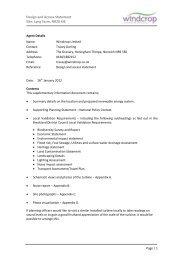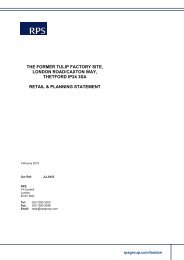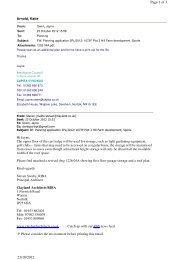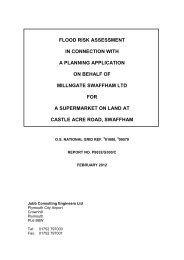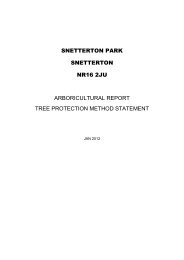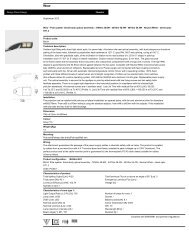Design and Access Statement Site: Broad Marsh Chalet, NR17 1LN
NR17%201LN%20Design%20and%20Access%20Statement.pdf
NR17%201LN%20Design%20and%20Access%20Statement.pdf
You also want an ePaper? Increase the reach of your titles
YUMPU automatically turns print PDFs into web optimized ePapers that Google loves.
<strong>Design</strong> <strong>and</strong> <strong>Access</strong> <strong>Statement</strong><br />
<strong>Site</strong>: <strong>Broad</strong> <strong>Marsh</strong> <strong>Chalet</strong>, <strong>NR17</strong> <strong>1LN</strong><br />
Supporting Planning <strong>Statement</strong> – National Policy considerations.<br />
Wind energy is an abundant natural resource. It is non-polluting, clean <strong>and</strong> sustainable. The UK<br />
has one of Europe‘s windiest climates <strong>and</strong> wind energy is expected to be an important element<br />
in achieving the targets contained in the government’s UK Low Carbon Transition Plan<br />
published in Summer 2009. The overall target is to reduce carbon dioxide emissions to 34%<br />
below 1990 levels by 2020. In 2008 the UK agreed to achieve 15% of our national energy<br />
consumption from renewable energy by 2020, from a starting point of just 1.3% in 2005. More<br />
specifically, it is Government policy to achieve 30% of the nation’s electricity requirements<br />
from renewable sources by 2020. The Committee on Climate Change were asked by the new<br />
Coalition Government to review these targets <strong>and</strong> concluded in September 2010 that they<br />
should remain at their previously agreed levels.<br />
Planning Policy <strong>Statement</strong> 22 (PPS22), Renewable Energy (August 2004) <strong>and</strong> the accompanying<br />
Companion Guide, cover all aspects of renewable energy including considerations for the siting<br />
of wind turbines <strong>and</strong> encourages favourable views towards small scale renewable power<br />
sources. The PPS, Companion Guide <strong>and</strong> Technical Annex identify a number of specific issues<br />
that need to be considered when determining an application for planning permission:<br />
<br />
<br />
<br />
<br />
Noise: paragraph 41 of the Technical Annex states that noise levels from wind turbines<br />
are generally low <strong>and</strong>, under most operating conditions, it is likely that turbine noise<br />
would be completely masked by wind-generated background noise. The report, ‘The<br />
Assessment <strong>and</strong> rating of noise from Wind Farms (ETSU-R-97), describes a framework<br />
for the measurement of wind farm noise <strong>and</strong> gives indicative noise levels calculated to<br />
offer a reasonable degree of protection to wind farm neighbours, without placing<br />
unreasonable restrictions on wind farm development or adding unduly to the costs<br />
<strong>and</strong> administrative burdens on wind farm developers or planning authorities. The<br />
report can be regarded as relevant guidance on good practice. This methodology<br />
overcomes some of the disadvantages of BS4142 when assessing the noise effects of<br />
wind farms, <strong>and</strong> should be used by planning authorities when assessing <strong>and</strong> rating<br />
noise from wind energy developments (PSS22, paragraph 22).<br />
Visual <strong>and</strong> L<strong>and</strong>scape Impact: Of all renewable technologies, wind turbines are likely<br />
to have the greatest visual <strong>and</strong> l<strong>and</strong>scape effects. However, the impact of turbines on<br />
the l<strong>and</strong>scape will vary according to the size <strong>and</strong> number of turbines <strong>and</strong> the type of<br />
l<strong>and</strong>scape involved, <strong>and</strong> these impacts may be temporary if conditions are attached to<br />
planning permissions which require the future decommissioning of turbines.<br />
Safety: the Technical Annex identifies little or no risk arising to the public <strong>and</strong> states<br />
that properly designed <strong>and</strong> maintained generators are a safe technology.<br />
Ecology: PPS22 (paragraph 15) states that local nature conservation designations<br />
should not be used in themselves to refuse planning permissions for renewable energy<br />
developments. The Technical Annex states that the impact of a wind farm on local<br />
ecology should be minimal. A common concern has been the risk of bird strike; more<br />
recently, an additional concern around the risk of harm to bats has emerged.<br />
Electro-magnetic Production <strong>and</strong> Interference: the Technical Annex (paragraph 64)<br />
states that provided careful attention is paid to siting, wind turbines should not cause<br />
any significant problems of electrical interference. Scattering of signal is a<br />
Page | 4




